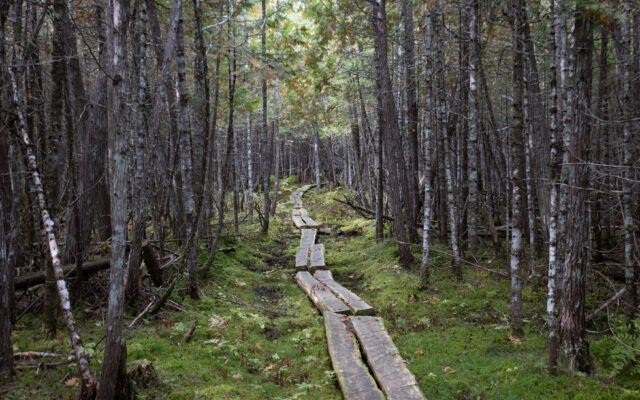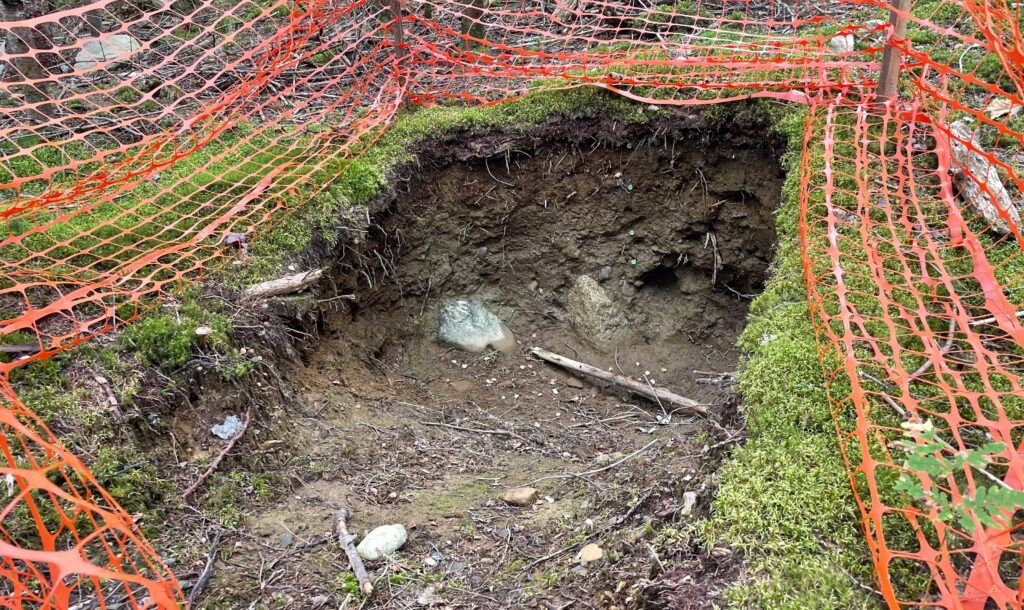
This family hike has a story walk and unique surprises
By Aislinn Sarnacki
Upon arriving at Law Farm Nature Trails in Dover-Foxcroft, my first thought was: Well, this is more than I expected!
We were just a few steps from the parking lot, and I could see a pollinator garden, a plantation of young chestnut trees and the start of a story walk that disappeared into the woods. Nearby, a group of women were sitting at picnic tables inside a building, which had one side open to the beautiful property.
My visit to Law Farm was impromptu, a side trip on the way back from a hike at the nearby Williamsburg Forest. So I hadn’t thoroughly researched the property ahead of time. I only knew that it had about a mile of trails, plus some fields.

BOG BRIDGE — A long stretch of bog bridges travels through a beautiful, mossy forest at Law Farm on Sept. 29 in Dover-Foxcroft.
As I studied the map posted at the parking area, I was excited to see that the trail network contained highlights such as a bog walk overlook and an educational apple orchard. Also marked on the map were two landmarks called “soil pit demonstrations,†which sparked my curiosity.
Steven and Elaine Law purchased the property in 1945, and deeded it to the Piscataquis County Soil and Water Conservation District in 2009. Their intention was to place it in the hands of an organization that could manage the forest and teach others about the importance of our natural resources.
Since then, PCSWCD has transformed the land into an outdoor learning space with the help of multiple grants and the work of volunteers. Features are continually being added and improved. The pollinator garden, for example, was created in 2019, and the bog overlook was just reconstructed last year.

NESTING BOX — A bird nesting box stands in a field at Law Farm in Dover-Foxcroft. The property is great for birding.
With my dog, Juno, on leash, I wandered over to the pollinator garden to watch bees and bee-like flies buzz between bright pink asters. From there, we headed into the forest on a loop trail marked with white blazes.
A thick carpet of moss covered the forest floor, dotted with bunchberry and wintergreen plants. Clusters of tall ferns edged the trail, their green fading to reveal autumn shades of gold and burnt orange. And in one especially magical area, freshly fallen maple leaves littered the ground, cloaking it in red.
A wooden deck with two long benches sat at the bog overlook, where an interpretive sign provided information about the habitat. The spot provided a partial view of the wetlands, with trees crowding in on both sides.

SOIL PIT — The Law Farm Nature Trails feature two soil demonstration pits.
The “soil pit demonstrations†turned out to be rectangular pits measuring perhaps from 2 to 3 feet deep. They were fenced off, so people don’t accidentally fall in, I’m assuming. Their purpose is to show natural layers of soil, also known as “horizons,†according to an interpretive display that stands beside each pit.
From the display, I also learned that Chesuncook is the official state soil of Maine. It’s a soil type that was first identified in Maine, and it’s one of the most widely distributed soils in the state. The name is a Wabanaki word for converging bodies of water.
I tried to dig deeper (excuse the pun) into the topic, and I quickly became intimidated by the world of soil taxonomy and classification. But I did learn that Chesuncook soils formed in glacial till, which is rock material left behind by glaciers. The soils are also deep and well-drained.
Once we completed the loop trail, we followed mowed paths around the fields. I imagine it’s a wonderful place to go birding in the spring and summer. Nesting boxes are scattered throughout the fields, and a bench to sit at and rest.
One of the mowed paths is called the Bluebird Trail because of the bluebirds that raise their young in the nesting boxes. The trail was dedicated to avid birder Madeline “Lynn” Lubas, who spearheaded a series of birding workshops and events that are now offered annually at Law Farm.
The mowed paths also lead to an organic Christmas tree stand, which was planted through the “Kids to Trees†program. Nearby, a fenced-off plot contained a variety of saplings that are native to Maine. A paper posted on the fence explains that it’s a University of Maine scientific study to learn about the impacts of heat and drought on tree regeneration.
Keep an eye out for interesting events happening at Law Farm on the PCSWCD website: piscataquisswcd.org. Coming right up, from 9 a.m. to noon on Oct. 28, you can visit the property to learn about caring or fruit trees in the fall.
You can rent the outdoor education classroom building for workshops and events, and you can book educational tours, as well.
Or, if you just happen to be driving through the area like I was, head on over to Lee Cemetery Road. The gravel parking area is hard to miss, and the trail network is open to visitors year round.